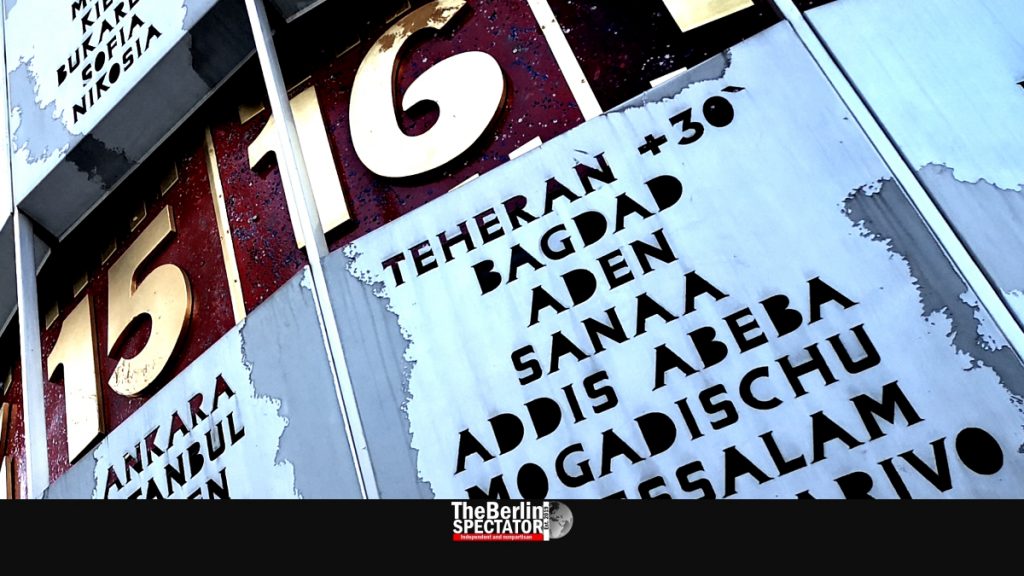It’s not like citizens of the GDR, the former communist German state, were big world travelers. Few flew to New York, New Delhi or Seoul. The confined majority got a World Clock.
Berlin, September 30th, 2019. Update: March 12th, 2021 (The Berlin Spectator) — The GDR’s spies and diplomats, as well as members of the regime and their families, citizens who were more equal that most others, travelled the world. Those who stayed behind, because they wanted their country so much that they had to be locked up in it, got to see the world on the new World Clock the regime ordered for the GDR’s 20th anniversary. Once that object was unveiled on September 30th, 1969, some 52 years ago, East Berliners knew what time it was in Tokyo, Rio de Janeiro and San Francisco.
Rotating Depiction of Solar System
Why go there? Knowing what the time it was over there was almost like being in San Francisco with flowers in your hair, taking a dip in the sea at the Copacabana or having Chicken Teriyaki sauce in Tokyo, right? Of course not. Building an object like this one for the GDR citizens was cynical.
Still, the construction quickly became one of the main sightseeing spots in East Berlin, and later in all of Berlin. It still is. Today, former inhabitants of the GDR do have the right to see the world symbolized by their World Clock, meaning the object with its 1960s GDR design does not cause travel lust that can not be fulfilled. Not anymore.

‘Weltzeituhr‘ is the German word for world clock. Nowadays, that word stands for the Berlin World Clock, in most cases, the somewhat weird looking object at Alexanderplatz. At its top, it has a rotating depiction of our solar system. Little metal spheres are the planets, metal bars are their orbits.
Slight Difference in Height
Further down, the names of 146 cities in the world accurately rotate through the Earth’s 24 time zones. Each section has its own color. At night, the World Clock does look interesting because the metal plates with the city names are illuminated.
The Berlin World Clock is protected by law, as a site of historic interest. For its 50th anniversary in 2019, the marketing rights were liberalized. What this means is that little World Clock models were being offered at souvenir shops.

Berlin’s television tower, located on the other side of Alexanderplatz train station, was inaugurated in 1969 as well, only four days after the World Clock. The slight difference in height, 386 versus 10 meters (1,266 versus 33 feet), is hardly noticeable.
Like an Iceberg
Similar to trees or icebergs, a significant part of the World Clock, which hardly anyone ever sees, is beneath the surface. Two meters (6.5 feet) under the ground, engineers can enter a rather large tech room. For instance it accommodates the electric motor which powers the ‘solar system’ and the transmission for the time zone ring. The latter is a modified transmission taken from a Trabant, one of those tiny cardboard vehicles the GDR regime called “cars”.

Further up, the single pillar which holds the World Clock is hollow and contains a metal ladder used by technicians to check or repair the upper part of the clock’s mechanisms. Some of the latter were modernized after Germany’s reunification. Cities the GDR ‘forgot’, Tel Aviv and Jerusalem, were added. Others were updated.
Back then, some 52 years ago in the GDR, the designer Erich John won a competition for an object the regime wanted to build in the city center. The leadership in East Berlin commissioned him. For the Clock’s 50th anniversary, Heike Schüler released a book entitled ‘Weltzeituhr und Wartburg-Lenkrad‘ (‘World Clock and Wartburg Steering Wheel’, in German only) in which she tells the entire story.
Center of the City
During her research, she found Erich John, a likable man who is 89 years old by now. Ahead of the anniversary, he was photographed in front of his World Clock. Back in 1968, he had drawn a first sketch of the construction he envisioned. The object turned out to look exactly like that sketch.

While checking old files, Heike Schüler found out that the Berlin World Clock has a predecessor. Underneath, there used to be some kind of a pillar set up in the 19th century, with regular clocks at the top and meteorology instruments fixed to it. The GDR regime picked up that idea, which Erich John modified.
In East Berlin, the World Clock was a popular meeting point, but the same applies today. “Shall we meet at Alexanderplatz?” “Yes, sure. World Clock, 5 p.m..” It can also be used as a giant, stationary umbrella. From the perspective of any spot in Berlin, it marks the center of the city.


